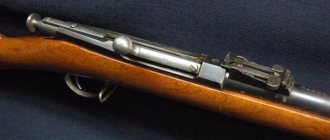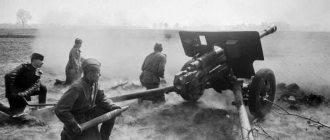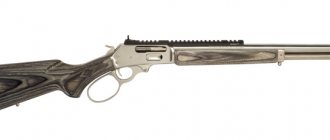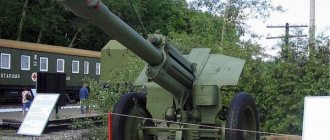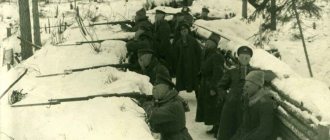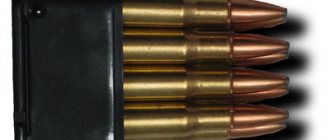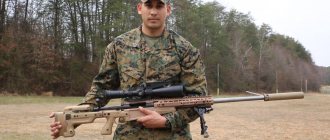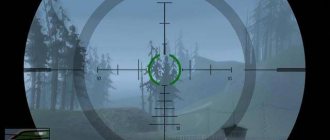| Mannlicher M1895 | |
| M95 rifle | |
| Type | magazine rifle |
| A country | Austria-Hungary |
| Service history | |
| Adopted | 1895 |
| In service | Armed forces of Austria-Hungary, Austria and Hungary, Troops of the Qing Empire, Italy, Russian Imperial Army, Armed Forces of Bulgaria (until the 21st century) |
| Wars and conflicts | Russo-Japanese War, World War I, World War II |
| Production history | |
| Constructor | Ferdinand Mannlicher |
| Designed by | 1895 |
| Manufacturer | Steyr Mannlicher[d], Fegyver- és Gépgyár and Zbrojvka Brno |
| Total issued | ~3,000,000 (before 1916) |
| Options | see options |
| Characteristics | |
| Weight, kg | 3.8 (M95 without cartridges) 3.36 (M95/30) |
| Length, mm | 1272 (M95), 1000 (M95/30) |
| Barrel length, mm | 765 (M95), 480 (M95/30) |
| Cartridge | 8x50 mm R M93 (M95) 8x56 mm R M30 (M95/30) 7.92x57 mm (M95/24) |
| Caliber, mm | 8 |
| Work principles | direct action shutter |
| Type of ammunition | integral magazine for 5 rounds |
| Media files on Wikimedia Commons | |
This term has other meanings, see M95.
Magyar soldier in the Carpathians with a Mannlicher M1895 rifle near the village of Volosyanka, 1940
Mannlicher M1895
, or
M95
(German: Mannlicher M1895) is a repeating rifle developed by Ferdinand Mannlicher and adopted by the Austrian-Hungarian army in 1895.
History of creation
Mannlicher system rifles mod. 1885 had a middle magazine for five rounds, a straight action bolt, the magazine was loaded from above one cartridge at a time, the caliber was 11 mm, the Werndl rifle cartridge with black powder was used.
A new model from 1886 with the same bolt, the same caliber, but loading is done using a pack. The bottom window in the magazine box is open to allow the empty pack to pass through: pack and drum magazines were invented before the introduction of smokeless powders. This system turned out to be the fastest-firing and was adopted by the Austro-Hungarian army, but due to the adoption of the Lebel rifle in France, Mannlicher was asked to create an 8 mm caliber rifle.
In 1888, Mannlicher created a repeating 8-mm rifle, which was tested and adopted into service in Austria-Hungary that same year. Rifles of this type served in Austria-Hungary until 1895, when the Steyr Mannlicher M1895 was adopted, then the 1888 model rifles were sold to Bulgaria.
Until 1890, cartridges were filled with black powder, which accelerated the bullet to 500 m/s.
Since 1890, smokeless powder and steel-jacketed bullets were introduced. The initial bullet speed was 625 m/s.
The Austrian cartridge served as a model for the design of the Russian cartridge, which was used in the Mosin rifle.
Austro-Hungarian rifle mod. The 1895 is chambered in the same 8mm cartridge as the 1888 rifle. Although both rifles share the same cartridge, the rifle designs are different. In addition to the infantry-style Mannlicher rifle, two more types of rifles were introduced into the Empire: a shortened rifle (fitting) and a carbine. Subsequently, Mannlicher infantry rifles and carbines of the 1895 model were adopted for service in Bulgaria.
In 1909, a cartridge with a pointed bullet weighing 10 g and an initial speed of 850 m/s was approved. It was planned to convert rifles for it. The conversion was delayed because Austria intended to switch to the new Mannlicher-Schönauer rifle system (it was adopted for service in Greece in 1903). However, the Austrians did not manage to implement changes before the First World War.
Replacement of the Italian standard
Salvatore Carcano
Competitive tests were carried out in mid-1891. The competitors of the Carcano rifle were the Bertoldi rifle, which was another deep modernization of the Vitali rifle, a slightly modernized German rifle of the 1888 model, as well as a number of other projects from private firms and individual engineers. Despite the fact that the Carcano rifle was developed by a very narrow circle of designers, it proved to be better than all others. The head of the commission, General Gustavo Parravicini, praised its simplicity of design, as well as its fast reloading, which does not require much effort. Thus, this particular rifle was declared the winner of the competition, but at the same time the commission put forward a number of claims and constructive proposals, which Carcano immediately undertook to correct and implement. In addition, he matured several of his own ideas, which were soon realized in metal. First of all, this affected the design of the magazine and the pack - after much deliberation, in order not to greatly reduce the magazine capacity relative to the Vitali rifle, which had an under-barrel magazine for 10 rounds, it was decided to use a two-row pack of the original design. To do this, it was necessary to redo the bolt design and expand the magazine, which also required modifications to the stock. The original welt cartridge was poorly suited for the new pack, and therefore the development of a new ammunition began. This time Carcano collaborated with German specialists, as a result of which the 7x57mm cartridge was born, which was a modernization of the standard 8-mm German cartridge. At new tests, held a year after the competition, the updated version of the Carcano rifle received rave reviews from the military, and was finally adopted for service under the name Carcano Modello 1892, or simply M92.
Description
Rifles (far left M1888), carbines and fitting Mannlicher M1895
The most characteristic feature of the Mannlicher rifle is the “direct action” bolt, with a straight, non-rotating stroke when reloading; The rotation of the bolt cylinder for locking was carried out automatically due to special spiral grooves on its stem. This increased the rate of fire and ease of use of the weapon, but complicated its design, reduced reliability and increased the effort exerted by the shooter when reloading.
The rifle's permanent magazine is equipped with a metal pack of 5 rounds, which remains in the magazine until they are used up, after which the pack falls out through a window in the bottom of the magazine. An unspent pack can be removed through the open bolt after pressing the latch located in the rear of the magazine, combined with the trigger guard. These rifles used the original packs with grooves on the top to make loading easier.
The M1895 was distinguished by its high accuracy, rate of fire and durability. The recoil was easily perceived by the shooter, which had a positive effect on accuracy. Before the First World War, it was considered good manners among the officers of the Russian Imperial Army to criticize this weapon for being sensitive to contamination due to the large window in the receiver. However, the outbreak of hostilities did not confirm the essence of this problem: contamination of the mechanism certainly occurred, but most of it eliminated itself with the same ease with which it arose[1].
loading a carbine
The carbine had the following good qualities: great strength, low recoil and good accuracy. Particularly valuable qualities for a cavalry carbine were the ease of loading on horseback, a high rate of fire, a durable safety catch, comfortable carrying on a belt over the shoulders and the low weight of the carbine. It should be admitted that the Mannlicher carbine was designed very successfully [1].
Kennedy assassination rifle
In March 1963, Lee Harvey Oswald purchased a "6.5 Italian carbine", later incorrectly called Mannlicher-Carcano, through mail order, for $19.95.
The advertisement only specified "6.5 Italian Carbines" and actually shows the M91 Carcano TS model, which was the 36" Carcano carbine model sold through the ad when it was originally placed. However, since 11 months before Oswald placed his order, the Chicago sporting goods store from which he purchased it had been shipping a slightly longer (40.2-inch) Model 91/38 according to the same ad, and this - the weapon that Oswald received. Official reports concluded that Oswald used this weapon to assassinate US President John F. Kennedy on November 22, 1963. The rifle, made at the Terney Arsenal in 1940 and bearing registration number C2766, was equipped for an additional $7 with an inexpensive new 4x18 Japanese optical sight on the side mount of sheet steel. It was later scrutinized by local police, the FBI, the US Army and two federal commissions. Shooting tests conducted by those groups and others using the original rifle or similar models raised questions about the speed and accuracy with which the Carcano could be fired. Following lawsuits over her property, the rifle ended up in storage at the National Archives. The murder was one of the factors leading to the passage of the Gun Control Act of 1968, which banned mail order sales of firearms.
Mannlicher rifles in the East
During the occupation of the Port Arthur fortress, the Russian Imperial Army “inherited” from the Qing troops a significant number of Mannlicher rifles, mainly of the 1886 model chambered for black powder cartridges and a direct action bolt. During the siege of the fortress in 1904, the captain of the 26th Infantry Regiment I.B. Shmetillo proposed and implemented a project for a makeshift “machine gun”. The Shmetillo machine gun was actually a device for firing volleys of 5-8 Mannlicher rifles mounted on a wooden frame. The bolts of the rifles were combined into one movable unit using a metal rod, allowing the shooter to simultaneously reload all rifles, and by moving another rod that united the triggers, firing shots from all barrels at the same time. Retargeting was performed by moving the entire frame and, as a rule, was not performed during battle.
What is Mannlicher-Carcano?
You can often come across the term “Mannlicher-Carcano”. Many are beginning to think that this is another modification of the M95 small arms, but this is somewhat not true. Here we are talking about a unitary cartridge, which was used by the Italian military during the 1st and 2nd world wars.
It has proven to be very effective at distances of 200-300 meters. In terms of power it belonged to intermediate cartridges. The Mannlicher-Carcano was also used by the Finns in the war against the USSR. Subsequently, Finnish troops received the Carcano small arms, which had nothing to do with Mannlicher. President Kennedy was shot with a Mannlicher-Carcano. A rifle chambered for this cartridge was never created, but several models were converted. In modern museums you can find outdated bullets that have a blunt ogival part. They were replaced with pointed ones, which were considered more effective and penetrating.
Options
M95/30
- Infanterie Repetiergewehr M.95
- infantry rifle mod. 1895 with a 765 mm barrel. - Kavaliere Repetierkarabiner M.95
- cavalry carbine mod. 1895 with 500 mm barrel, without bayonet mount - Extra-Korps-Gewehr M.95
(
RepetierStutzen M1895
) - a fitting of the 1895 model, with a 480 mm barrel and a bayonet mount, had a second front sight on the bayonet blade - for artillerymen, engineering troops and other specialized units. - M95/24
- modification mod. 1924 chambered for 7.92×57 mm with a barrel shortened to 580 mm. - M95/30
- Austrian modification mod. 1930 chambered for 8 × 56 mm R - M95/31
- Hungarian modification mod. 1931 chambered for 8 × 56 mm R.
Mannlicher carbine: technical characteristics
A distinctive feature of the 1895 model carbine was a shortened barrel, a modernized sight and stock. In this case, a standard cartridge and a straight bolt were used, which, as we have already figured out, is not without its drawbacks. It is interesting that such a rifle of the Austro-Hungarian army did not have a bayonet. Mannlicher did not foresee this. At the same time, the carbine was loaded just as quickly and conveniently as the infantry version, which gave a significant advantage in battle. In addition, the weapon had relatively low recoil and light weight, so it could be carried over the shoulder without significant energy expenditure. Such a carbine is convenient to reload on horseback, and the strength of the fuse is at a high level.
Operating countries
- Austria-Hungary - in service from 1895 until the collapse of Austria-Hungary in 1918
- Bulgaria - since 1903 in service with the Bulgarian army, after Bulgaria joined the Central Powers in 1915, the Bulgarian army began to receive additional weapons from Austria-Hungary, after the end of the First World War, rifles remained in service with the Bulgarian army and as of September 9, 1944 were the main type of rifle in the Bulgarian army[2]
- Russian Empire - during the First World War, captured Mannlicher rifles were widely used in the Russian army due to a shortage of domestic rifles and ammunition for them[3]; already at the beginning of the war, state militia squads[4], rear units of the army and navy[5], and later - parts of the active army[6] were re-equipped with Austrian weapons.
- Kingdom of Serbia - during the First World War, captured Austrian rifles were used in the Serbian army; in addition, in January 1916, a Serbian detachment formed in the Odessa Military District of the Russian Empire was armed with captured Austrian rifles[7]
- Italy - a number of captured rifles were captured during the First World War; After the surrender of Austria-Hungary in 1918, Italy had at its disposal a significant number of rifles received as reparations. For rifles, the production of Italian-made 8x50 mm R cartridges was launched. By the beginning of the Second World War, rifles and carbines were still in service with auxiliary units under the name Fucile Mannlicher 95
and
Moschetto Mannlicher 95
[8] - Austria - in service with the Austrian army from the formation of Austria in October 1918 until the Anschluss in March 1938, later the rifles became available to the Wehrmacht; in 1945 a number were transferred to the gendarmerie ( Österreichische Gendarmerie
), withdrawn from service in 1955. - Hungary
- Yugoslavia - after the end of the First World War, captured rifles of the Austro-Hungarian army remained in the army warehouses of the mobilization reserve until the occupation of Yugoslavia in April 1941. Subsequently, these rifles were used by the NOAU partisans[9]
- Czechoslovakia - at the beginning of 1919, at the Zbrojovka Brno plant, production began, first of spare parts, and then of Mannlicher rifles model 1895, which continued until July 22, 1921 (however, 8x50 mm R cartridges were produced until the mid-1930s , mainly for export). In 1922, it was decided to leave only Mauser rifles chambered for 7.92x57 mm in service with the Czechoslovak army; rifles of other systems were removed from service[10]
- Second Spanish Republic - 27 thousand 8-mm Mannlicher rifles and carbines of the 1888, 1890, 1891 and 1895 models were used by Republican troops during the war in Spain[11]
- Poland - a number of rifles mod. 1895 chambered for 8×50 mm R entered service with the police in the 1920s
- Francoist Spain - during the war in Spain, a significant number of 8-mm rifles mod. 1895 (from the warehouses of the Austrian army, which were at the disposal of the Germans after the Anschluss of Austria in March 1938) and 5000, captured on April 15, 1937 on the steamer "Gordenia", carrying them to the Republicans, were delivered to the Francoists[12]
- Greece - a number of rifles mod. 1895 chambered for the 8x50 mm R cartridge was available in Greece; after the occupation of Greece in April 1941, they became available to the Wehrmacht under the name Gewehr 306(g)
- RSFSR and USSR - during the civil war they entered service with individual units of the Red Army (mainly in rear units and units of internal troops)[13]; in 1941, a certain amount was transferred to the armed forces of the people's militia [ clarify
]. - Germany - came into the possession of the Wehrmacht after the Anschluss of Austria in March 1938, during the Second World War a number entered service with auxiliary and security police units (Austrian rifles were used under the name Gewehr 98 (ö)
, a number of rifles and carbines were captured during the disarmament of Italian troops in 1943, it entered service under the name
Gewehr 306(i)
and
Karabiner 505(i)
); in the fall of 1944, during the formation of Volkssturm battalions in Germany, 7,214 units were transferred from reserve warehouses to equip them, among other captured and obsolete weapons. 8-mm Austrian rifles Mannlicher M95[14].
Carcano rifle 1892
Structurally, the Carcano rifle of the 1892 model was a typical representative of its time. It had a longitudinally sliding butterfly valve of Salvatore Carcano's own design, which was quite simple and technologically advanced. The barrel was locked by two lugs in the front part of the bolt; the base of the bolt handle served as a third (safety) lug. The handle itself was moved slightly forward for the convenience of the shooter due to the significant bolt travel when loading. In this case, it was necessary to make a cut in the upper rear part of the receiver for the bolt handle to move along it. The integral box magazine held ten rounds in a pack, which remained in the magazine until all the cartridges were used up. After the cartridges were used up, the pack fell out of it down through a special window under its own weight. The manual safety was located at the rear of the bolt, and had two positions, up (safety on) and to the right (fire). The sights on the rifles were open and adjustable. The barrel was threaded with a progressive step, which complicated and increased the cost of production, but at the same time increased the accuracy and accuracy of fire. To attach the belt, two large lower swivels were used; on a military carbine, the upper swivel was attached to the barrel on the left side, and instead of the lower one, a special slot was used on the left side of the butt. The bayonet used was a standard cleaver bayonet, attached to the barrel from below. The military carbine instead had an integral needle bayonet, which folded back or forward on a hinge. The ammunition used was a 7x57mm cartridge with a blunt bullet, which provided impressive ballistic qualities for its time - high accuracy, accuracy, muzzle velocity and firing range. At the same time, in contrast to cartridges of caliber 7.62 mm and larger, the 7 mm cartridge had less recoil, which made shooting much less tiring and simpler, and also reduced the load on the shooter during prolonged firing.
The Model 1892 rifle was produced in three different versions:
- Carcano Modello 1892 Fucile di Fanteria is an infantry rifle with a barrel length of 750mm. It was intended to arm the linear and marine infantry, velites, alpini and praetorian guards. In fact, it was highly valued only by line infantry, while other units preferred the military carbine.
- Carcano Modello 1892 Moschetto per Truppe is a military carbine with a barrel length of 560 mm. In general, it was a shortened version of an infantry rifle, with minor differences in the shape of the stock and small details. Intended for rear and auxiliary troops, but instead became popular as the main weapon of Marines, Velites and Alpini.
- Carcano Modello 1892 Moschetto da Cavalleria is a cavalry carbine with a barrel length of 450mm. It was noticeably different from an infantry rifle due to a shortened stock, a different belt fastening and the presence of a folding bayonet. It was intended for arming cavalry, but became quite popular in various auxiliary troops due to its compactness.
The first reviews received from the troops about the rifle were generally positive, but gradually comments and suggestions for improving the design of the rifle began to accumulate. In response to this, Salvatore Carcano conducted large-scale comparative tests of his rifle with foreign models, and in 1900 began work on a deep modernization of his brainchild. This work will take two whole years, and will result in the creation of the Model 1902 - one of the best repeating rifles in history.
Mannlicher rifle in literature and art
Mannlicher rifles are mentioned in many literary and artistic works.
- A. Stepanov “Port Arthur” In the battle scenes, a significant place is occupied by “old Chinese rifles”, which are Mannlicher rifles inherited from the troops of the Qing Empire.
- A. Kozachinsky “Green Van” policeman Grishchenko is armed with a Mannlicher rifle.
- Mannlicher rifles under the disparaging name “Manlicher rifles” are mentioned in Jaroslav Hasek’s novel “The Adventures of the Good Soldier Švejk.”
- E. Hemingway in the story “The Short Happiness of Francis Macomber” the main character is killed by his own wife with this rifle.
- In A. Dovzhenko’s silent film “Arsenal” (another title “Uprising in Kyiv in 1918”), Austro-Hungarian units are advancing on Ukraine with “Mannlicherovka” in their hands.
- With this rifle in his hands, its first commander, Colonel Nezhentsev, went to attack the Kornilov Regiment. But he was killed by an exploding shell. (From the memoirs of a pioneer - a participant in that battle)
- In Boris Akunin’s novel “I Don’t Say Goodbye,” Erast Fandorin takes the Mannlicher rifle from the bandits and shoots back with it.
- Media files on Wikimedia Commons
Notes
- ↑ 1 2
Vladimir Fedorov “In search of weapons” ch. War is a school for a gunsmith - History of the Patriotic War in Bulgaria 1944-1945 (in 4 vols.). tom parvi. Sofia, Military Publishing House, 1981. p.308
- “ During the First World War, Tsarist Russia lacked small arms, so in addition to Russian-style rifles, the army also had foreign ones - Japanese Arisaka models 1897 and 1905, Austro-Hungarian Mannlicher 1889 and 1895, German “88” and "98".
In addition to these rifles, obsolete models were also used, firing cartridges filled with black powder - Berdan No. 2 model 1870, Gra 1874, Gra-Kropachek 1874/85, Vetterli 1870/87 "A. B. Zhuk . Encyclopedia of small arms: revolvers, pistols, rifles, submachine guns, machine guns. M., AST - Voenizdat, 2002. p.587 - M. V. Oskin. State militia during the First World War // “Questions of History”, No. 6, June 2013. pp. 142-152
- “ The supply of rifles was exhausted within 2-3 months of the war, and cartridges and shells by mid-December 1914.
At the beginning of 1915, Russian industry satisfied the needs of the troops for weapons and ammunition by an average of 15-30%... forced measures in the form of rearmament of the rear units of the army and navy with obsolete Berdan guns and Austrian captured weapons (which made it possible to free up 500 thousand rifles for active units) and the accelerated dispatch of local parks prepared in peacetime to the troops could not significantly change the situation » R. Ernest Dupuis, Trevor N. Dupuis. World history of wars (in 4 vols.). book 3 (1800-1925). SPb., M., “Polygon - AST”, 1998. p.782 - “ During the autumn and winter of 1915... the tsarist army no longer had enough of its own rifles.
Many soldiers, in particular our entire regiment, were armed with captured Austrian rifles, fortunately there were more cartridges for them than for ours. "A. M. Vasilevsky. Life's work. 7th ed. book 1. M., Politizdat, 1990. pp. 21-22 - " January 19, 1916.
In the Odessa Military District, with the participation of a representative of the Serbian Army Colonel Lontkievich and Major Peiovich, who left us, a Serbian detachment is being formed... Our equipment and uniform, Serbian caps, weapons - Austrian guns "M. K. Lemke. 250 days at the Tsar's Headquarters 1914-1915. Minsk, Harvest, 2003. - Alexander Bortsov. Cartridges of Italy // magazine “Master Gun”, No. 1 (118), January 2007. pp. 66-70
- Velimir Vukcic. Tito's partisans. London, Osprey Publishing Ltd., 2003. page 24
- Alexander Bortsov. Cartridges of Czechoslovakia // magazine “Master Gun”, No. 11 (116), November 2006. pp. 62-67
- Fusiles and mosquetones de la Infanteria Republicana
- Alejandro de Quesada, Stephen Walsh. The Spanish Civil War 1936-39 (1). Nationalist Forces. London, Osprey Publishing Ltd., 2014. page 38
- Rifle // Civil war and military intervention in the USSR. Encyclopedia / editorial coll., ch. ed. S. S. Khromov. — 2nd ed. - M., “Soviet Encyclopedia”, 1987. p.94
- Sergey Monetchikov. Submachine guns for the Volkssturm // “Weapons” magazine, No. 2, 2002 (special issue “Infantry weapons of the Third Reich. Part IV. Submachine guns”)
Some more interesting historical facts
In 1930, in Austria, it was decided to convert the rifle to the 8x56R cartridge, since it was more powerful. The main changes affected the barrel, which was significantly shortened, and the small arms also received a new, modernized sight.
Following Austria, Hungary also began modernization. It is worth noting that Hungarian rifles, like Austrian ones, were actively used during the Second World War. In 1885, Mannlicher developed a magazine with burst loading. A single-row magazine was used in a metal pack, which remained until the cassette was completely discharged. By and large, the Mannlicher rifle was very convenient to use, but sometimes it let the soldier down. This happened for various reasons, which we will talk about a little later.

